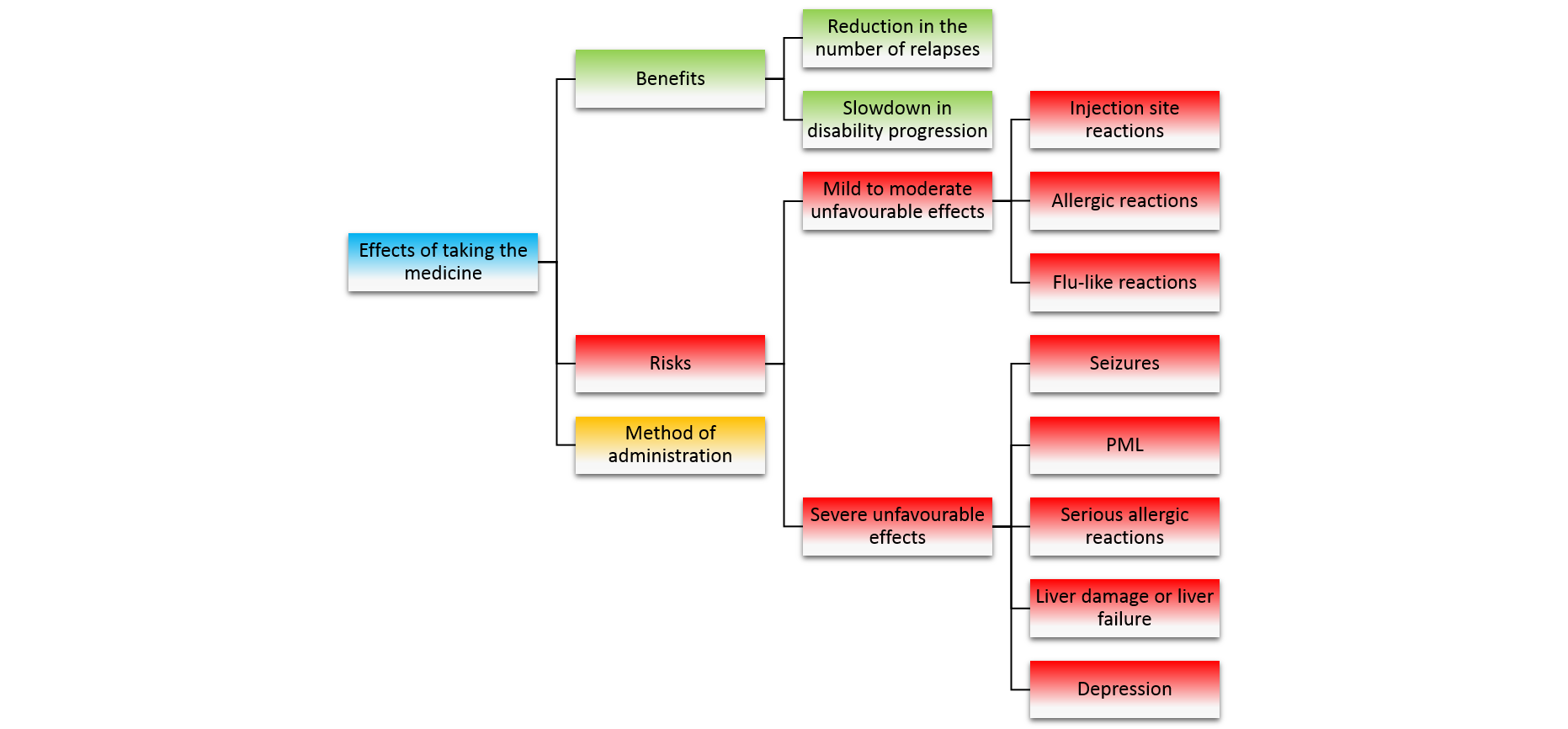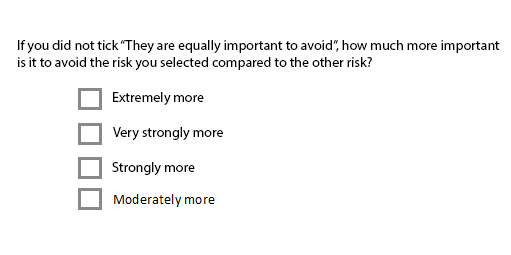How we found out what is important to patients: an example
Why did we begin this work?
Although there is strong justification to ask patients and the public for their preferences on the benefits and risks of treatments, there are two main challenges: (1) there are many different types of methods which can be used to ask preferences but have not been used within this context, (2) they have not been formally tested with patients and the public. We planned to explore and address these concerns.
What were our methods?
Our aim was to evaluate the benefit-risk balance of natalizumab (Tysabri) used to treat relapsing remitting multiple sclerosis from the patient perspective using publicly available benefit and risk data. The benefits and risks criteria that we included in our study are listed in the table below:| BENEFITS | RISKS | ||
|---|---|---|---|
| (1) Reduction in the number relapses | (1) Infusion or injection site reactions | ||
| (2) Slowdown in disability progression | (2) Allergic reactions | ||
| (3) Flu-like reactions | |||
| (4) Seizures | |||
| (5) Progressive multifocal leukoencephalopathy | |||
| (6) Serious allergic reactions | |||
| (7) Serious liver problems or liver damage | |||
| (8) Depression |
These benefits and risks can be represented as a value tree, and are displayed in the diagram below.

Click on the tabs below, a description will appear to give you more information about the benefit or risk.
Benefits
-
A relapse is defined by "the appearance of new symptoms, or the return of old symptoms, for a period of 24 hours or more – in the absence of a change in core body temperature or infection" (Source: MS Society). Medical staff might call relapses things like attack, flare-up, exacerbation, acute episode or clinical event. Symptoms you have experienced before, or perhaps grown used to dealing with, might appear in a different part of the body. In relapses, symptoms usually come on over a short period of time – over hours or days. They often stay for a number of weeks, usually four to six, though this can vary from very short periods of only a few days to many months. Relapses can vary from mild to severe. At their worst, acute relapses may need hospital treatment, but many relapses are managed at home, with the support of the GP, MS specialist nurse, and other care professionals. Symptoms which come and go can sometimes be considered a relapse – they don’t always have to be continuous. For example, some people experience a shock-like sensation when they bend their neck. This can be considered a relapse if it occurs every time they bend their neck for at least 24 hours.
-
One way of measuring disability progression in MS is the EDSS: Expanded Disability Status Scale. The EDSS Score is a 10-point scale to quantify disability in multiple sclerosis and to monitor changes in the level of disability over time. It is based around the following 8 symptoms:
(1) weakness or difficulty moving limbs, (2) a loss of coordination or tremor, (3) issues with speech, swallowing, or your eyes darting around (nystagmus), (4) numbness or loss of sensations, (5) issues with bowel and bladder function, (6) issues with visual function, (7) issues with certain mental functions, (8) issues with other functions.
Risks
- Injection site reactions
- Allergic reactions
- Flu-like reactions
- Seizures
- PML
- Serious allergic reactions
- Liver problems
- Depression
-
What are the symptoms? How long do they last for? Can the symptoms be treated? Injection or infusion site reactions can happen at the infusion or injection site on the body. Injection or infusion site reactions include: redness, bruising, itching, swelling, hardening, pain, rash and/or a lump at the location. Most injection or infusion site reactions happen right away or soon after treatment and fade after a few days. Some injection or infusion site reactions can be treated with over the counter medicines available from a pharmacist or medicines which your doctor may prescribe. -
What are the symptoms? How long do they last for? Can the symptoms be treated? The symptoms of mild allergic reactions may include: hives and/or rash, itching, trouble breathing and/or wheezing, chest tightness and/or chest pain, heart palpitations (e.g. heartbeats which feel like they are fluttering or pounding), dizziness, chills, nausea, flushing of skin (skin is red and/or feels warm), low blood pressure, anxiety, sweating, shaking or shivering. These reactions can happen immediately or within a few hours of receiving treatment. The symptoms do not usually cause any problems and pass quickly. In some cases they can last for as long as thirty minutes Some mild common allergic reactions can be prevented on treatment days by taking over the counter medicines (e.g. paracetamol, ibuprofen) available from a pharmacist or other medicines which your doctor may prescribe. What are the symptoms? How long do they last for? Can the symptoms be treated? The symptoms of flu-like reactions are very similar to experiencing flu and may include muscle aches, tiredness, fever, chills, and headaches. Flu-like reactions may last for one to seven days after receiving treatment. Some flu-like reactions (e.g. fever and muscle aches) can be prevented on treatment days by taking over the counter medicines (e.g. paracetamol, ibuprofen) available from a pharmacist or other medicines which your doctor may prescribe. -
What are the symptoms? How long do they last for? Can the symptoms be treated? Symptoms of seizures are uncontrollable changes in body movement or function (e.g. shaking rapidly and uncontrollably), sensation, awareness (e.g. loss of consciousness), and/or behaviour. Seizures may also be referred to as fits or convulsions. Seizures are usually quite short, often lasting a few seconds to 15 minutes. For most people this will be a one-off event. Seizures usually require immediate medical attention, anticonvulsive treatment and hospitalisation. -
What are the symptoms? How long do they last for? Can the symptoms be treated? PML is a viral brain infection. It can cause severe neurological symptoms, such as headaches, memory loss, changes in mental status, speech and vision difficulties, loss of strength, limb weakness, seizures, partial paralysis and loss of coordination. Patients do not recover from PML; the symptoms rapidly worsen and usually lead to severe disability (e.g. permanent neurological damage) or death. PML requires immediate medical attention and hospitalisation. There is no known treatment cure for PML. -
What are the symptoms? How long do they last for? Can the symptoms be treated? Serious allergic reactions affect the whole body. Symptoms may include difficulty breathing, extremely low blood pressure, loss of consciousness and shock. Serious allergic reactions usually take place two hours after the start of treatment but can happen at any time after receiving treatment. Depending on the type of serious allergic reaction, there may be full recovery or the reaction could be life-threatening and fatal. Serious allergic reactions require immediate medical attention and hospitalisation -
What are the symptoms? How long do they last for? Can the symptoms be treated? The symptoms of liver problems may include: nausea, loss of appetite, tiredness, unusual darkening of urine, pale stools, yellowing of skin or the white part of your eye (jaundice), bleeding more easily than usual, confusion and sleepiness, vomiting, and feeling tired or weak. Liver problems usually occur several weeks after the start of treatment. They may result in liver failure and death. Severe liver problems can be prevented with regular monitoring of liver enzymes. The treatment is immediately stopped if the level of liver enzymes becomes too high and/or is high for a long time. -
What are the symptoms? How long do they last for? Can the symptoms be treated? Symptoms of depression may include feeling hopeless or feeling bad about oneself, and/or thoughts of hurting oneself and/or suicide. Depression can occur as part of experiencing MS, and may be worsened by the treatment If depression is experienced the treatment is stopped and psychiatric treatment is necessary e.g. cognitive behavioural therapy and/or antidepressants prescribed by a doctor.
Whose preferences did we seek?
We recruited a sample of relapsing remitting multiple sclerosis patients who were receiving treatment from Charing Cross and St. Mary’s Hospital, London, England.Participants were:
Which methods of asking patients for their preferences did we look at?
We looked at four different methods - click on each tab below to browse the questioning method.-
Analytic hierarchy process


-
Discrete choice experiment

-
Swing-weighting
Imagine a situation where all the outcomes are the worst they could be in the table below. Now imagine you can change one of them to be the best it could be.
- 1) Give a rank of 1 to the outcome you would most like to change from its worst to best value (all the others stay at the worst value).
- 2) Now rank the other outcomes the same way, according to how much you would like to change it from its worst to best value (all the others stay at the worst value).
- 3) On the scale below, mark the he outcome given a rank of 1 with a value of 100.
- 4) Now place the other outcomes on the scale to reflect their relative importance, and transfer these numbers to the final column of the table.


-
MACBETH

What were our results?

[This work is still in progress, results will be added once study is completed.]
